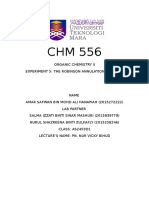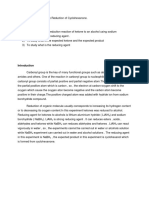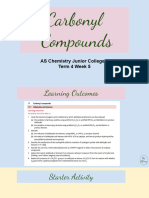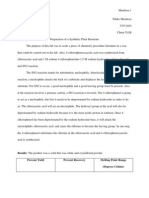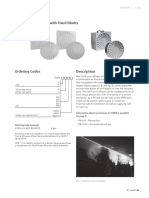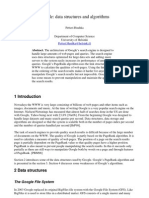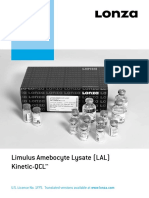Lab 8 (Ochem)
Lab 8 (Ochem)
Uploaded by
Darimi JohariCopyright:
Available Formats
Lab 8 (Ochem)
Lab 8 (Ochem)
Uploaded by
Darimi JohariOriginal Description:
Copyright
Available Formats
Share this document
Did you find this document useful?
Is this content inappropriate?
Copyright:
Available Formats
Lab 8 (Ochem)
Lab 8 (Ochem)
Uploaded by
Darimi JohariCopyright:
Available Formats
Lab # 8 A. Crossed Aldol Condensation B.
Haloform Reaction Darimi Johari, 6024045, CHM 2123, Section D TA: Soghra Jalil Pour Partner: Mohamad Kebbe Due date: November 24, 2011 1 Introduction Carbonyl reactions allow for the formation of a variety of compounds. This is caused by the resonance that influences the acidity of the alpha carbon and the oxygen double bond. Aldol Condensation In the case of crossed condensation reaction, 2 carbonyl compounds will react and form one product; one becoming an electrophile while the other becomes a nucleophile.
Self Condensation
To make the crossed condensation preparation useful, it is important to have only one of the compounds capable of forming the enolate (and so have the other compound not have an alpha hydrogen), and the other compound to not self condense rapidly. This can be achieved knowing that aldehydes self condense faster than ketones. This reaction can be seen with a bensaldehyde and an acetophenone, those that are used in this lab. With the given parameters, benzelacetophenone is able to be produced.
Haloform Reaction The haloform reaction occurs when a methyl ketone reacts with a halogen in a basic solution. This produces multiple halogenations at the carbon of the methyl group because the alpha hydrogens become more acidic as the electron withdrawing halogens are added. This is also partially determined by the inductive effect. The reaction results in a product known as a trihaloketone, a very strong electrophile. Nucleophilic attacks by a hydroxide can then occur on the carbon of the carbonyl to then produce a carboxylate anion and a haloform.
Trihaloketone is not formed during the lab because the trihaloketone intermediate is immediately attacked by OH which kicks out the CX3 for the carboxylate.
Formation of trihaloketone with a carboxylate product
2 Table of Reagents A. Crossed Aldol Condensation Compound Molar mass Quantity (g/mol) Acetophenone 120.16 1.0 mL Benzaldehyde 106.13 1.0 mL Ethanol 46.07 5.0 mL NaOH 39.9971 4.0 mL B. Haloform Reaction Compound Molar mass (g/mol) Acetophenone 120.16 NaOCl 74.44 Acetone 58.08 HCl 34.4606 3 Experimental procedure Refer to pages 74-76 of the CHM2123 Lab Manual, University of Ottawa. 4 Observations A. Crossed Aldol Condensation Steps Addition of EtOH, NaOH, and acetophenone Addition of benzaldehyde After 45 minutes Crystallization Crystals after being dissolved in boiling ethanol Re-crystallization B. Haloform Reaction Steps Addition of NaOCl and acetophenone Observations Highly viscous liquid, translucent, yellow Yellow liquid, opaque Peach colour with red precipitate on the bottom, opaque Red and orangish, After filtration and drying, became completely red Orange liquid Red coloured crystals Quantity 1.0 mL 1.0 mL 5.0 mL Density (g/mL) 1.028 1.0415 0.789 1.515 Density (g/mL) 1.028 12.06 0.79 1.2 mmol 8.56 9.81 85.63 3.788 mmol 8.56 16.2 68.0 Equivalents 2.26 259 22.61 1.00 Equivalents 1.00 1.89 7.94 -
Observations White liquid formed, opaque. After about 30 minutes, become transparent with bubbles liquid, transparent, Lots of bubbles, foamy, white liquid White crystals, powdery
Addition of acetone Addition of HCl Filtration
5 Results A. Crossed Aldol Condensation Experimental melting point: 50-52 C Mass obtained: 1.6 g Yield: 88.89% B. Haloform Reaction Experimental melting point: 119-120 C Mass obtained: 0.98 g Yield: 98% 6 Discussion The product of the first part of the lab was benzalacetophenone. Its appearance was that of red solid crystals with a melting point of approximately 51C. The yield of the product came to be about 89%. The yield was calculated by dividing the experimental mass by the theoretical mass. The results indicated a fairly accurate product based on the theoretical values. The loss in yield could be a result from dissolving the crude product in ethanol, and so cause the desired product to be too soluble in the solvent, making it harder to recrystallize. The product of the second part of the lab was benzoic acid. The appearance was a white powder with a melting point of around 120C, fairly close to the theoretical melting point of 121 to 125C. This slight difference in values can be attributed to the presence of impurities in the final product. The yield was fairly accurate at 98%. The addition of too much or too little HCl may have caused this slight disparity. Inaccuracies and mistakes during the lab can be attributed to a variety of sources of error. A few examples could have been from slight mistakes in measuring quantities, contamination on the given glassware, inefficient swirling of the reactions, and loss of product from filtration. These errors can be alleviated to an extent through better equipment and experience, proper cleaning of the tools, and continuous rewashing and multiple filtrations. 7 Questions Written on a separate paper.
You might also like
- Installation Procedure For Pressure Vessel - EnglishDocument8 pagesInstallation Procedure For Pressure Vessel - EnglishApri Dianto92% (13)
- Chm557 Laboratory Report: Experiment 4 The Aldol Condensation Reaction: Preparation of DibenzalacetoneDocument17 pagesChm557 Laboratory Report: Experiment 4 The Aldol Condensation Reaction: Preparation of DibenzalacetonesyafNo ratings yet
- Williamson Synthesis Lab ReportDocument5 pagesWilliamson Synthesis Lab ReportNicholas Johnson100% (2)
- Experiment 8 - The Preparation of AcetanlideDocument12 pagesExperiment 8 - The Preparation of AcetanlideMark Ryan Tripole92% (13)
- BS8519 2010 PDFDocument12 pagesBS8519 2010 PDFwaytobhushan100% (1)
- Solution Real Analysis Folland Ch5Document35 pagesSolution Real Analysis Folland Ch5ksNo ratings yet
- Aldol Condensation Reaction Lab ReportDocument4 pagesAldol Condensation Reaction Lab ReportAvril Watson100% (3)
- Synthesis of An Alkyl HalideDocument4 pagesSynthesis of An Alkyl HalideClyde Co SorianoNo ratings yet
- Sodium Boronhydride Reduction of CyclohexanoneDocument6 pagesSodium Boronhydride Reduction of CyclohexanoneWan Nur Amira91% (11)
- Typical Values of Z UsedDocument5 pagesTypical Values of Z UsedClarisse Angela PostreNo ratings yet
- Poster Presentation (Ashwani Singh - 117BM0731)Document1 pagePoster Presentation (Ashwani Singh - 117BM0731)Ashwani Singh0% (1)
- Aldol EditorDocument7 pagesAldol EditorLakshmi SubramaniNo ratings yet
- Chem 305 Lab OneDocument6 pagesChem 305 Lab OneGobe JamNo ratings yet
- Aldol Condensation LabDocument5 pagesAldol Condensation Labnmc515288% (8)
- Aldol Condensation Reaction PDFDocument6 pagesAldol Condensation Reaction PDFaizatNo ratings yet
- MethoxyacetophenoneDocument5 pagesMethoxyacetophenoneMarcelo MartinezNo ratings yet
- Chem 31.1 FR1 SantosDocument5 pagesChem 31.1 FR1 SantosClaire SantosNo ratings yet
- Katch UmbelliferoneffrDocument9 pagesKatch Umbelliferoneffrapi-456902531No ratings yet
- Exp 3-Reduction of Cyclohexanone With Sodium BorohydrideDocument11 pagesExp 3-Reduction of Cyclohexanone With Sodium Borohydrideakuserai100% (3)
- AldolDocument7 pagesAldolGindo Baroes WanNo ratings yet
- Lab 4Document8 pagesLab 4NelvianaNo ratings yet
- Experiment #1Document7 pagesExperiment #1Lakani Tindiwi YangalaNo ratings yet
- Case Study Questions AldehydeDocument24 pagesCase Study Questions Aldehydeaarushah227No ratings yet
- Synthesis of An Alkyl HalideDocument4 pagesSynthesis of An Alkyl HalideRuther CabralNo ratings yet
- Nucleophlic Acyl Substitution - The Synthesis of Ethyl ButanoateDocument5 pagesNucleophlic Acyl Substitution - The Synthesis of Ethyl ButanoateRuther Cabral67% (3)
- HB 31.1FR06Document3 pagesHB 31.1FR06hebieNo ratings yet
- CHM 556 Experiment 5Document12 pagesCHM 556 Experiment 5Amar Safwan100% (1)
- Carbonyl Ex 3Document5 pagesCarbonyl Ex 3Arabella VirgoNo ratings yet
- Friedel CraftsDocument8 pagesFriedel CraftsAhmed MashalyNo ratings yet
- Radical Coupling ReactionDocument7 pagesRadical Coupling ReactionGobe JamNo ratings yet
- Mapua Institute of Technology: School of Chemical Engineering and ChemistryDocument12 pagesMapua Institute of Technology: School of Chemical Engineering and ChemistryVon Joby RomeroNo ratings yet
- Soduim Borohydride Reduction of CyclohexanoneDocument10 pagesSoduim Borohydride Reduction of CyclohexanoneAlohaaSwezzNo ratings yet
- Adol Condensation of DibenzalacetoneDocument2 pagesAdol Condensation of DibenzalacetoneMohammad Bazrouk100% (1)
- The Aldol Condensation Reaction: Preparation of Benzalacetophenones (Chalcones)Document7 pagesThe Aldol Condensation Reaction: Preparation of Benzalacetophenones (Chalcones)ohhiNo ratings yet
- Orgo Lab.Document9 pagesOrgo Lab.ladyjacket42No ratings yet
- Exercise No 2. Lab Rep Organic ChemDocument7 pagesExercise No 2. Lab Rep Organic ChemIrish LaudeNo ratings yet
- Synthesis of Tert-Butyl Chloride Through Hydrochlorination of Tert-Butyl Alcohol and Purification Using DistillationDocument9 pagesSynthesis of Tert-Butyl Chloride Through Hydrochlorination of Tert-Butyl Alcohol and Purification Using DistillationAnonymous GO6JVW9Wud100% (2)
- 210 - 1,4-Di-T-Butyl-2,5-Dimethoxy Benzene and Acetanilide - Sp. 2023Document27 pages210 - 1,4-Di-T-Butyl-2,5-Dimethoxy Benzene and Acetanilide - Sp. 2023Abdallah EliasNo ratings yet
- Chem Lab Report 2 Deol ADocument5 pagesChem Lab Report 2 Deol AMagnolia Kaye Deola100% (1)
- Formal Report For Synthesis of An Alkyl HalideDocument5 pagesFormal Report For Synthesis of An Alkyl HalideLovelyn Marie Morada Nievales80% (5)
- Sodium Borohydride Reduction of Cyclohex PDFDocument8 pagesSodium Borohydride Reduction of Cyclohex PDFhahadindongNo ratings yet
- The Hydrogenation of AlkenesDocument8 pagesThe Hydrogenation of AlkenesMuhamad Nazrul BoyoteenNo ratings yet
- EXP2 ReportDocument6 pagesEXP2 Reportballa12345No ratings yet
- 4 +Proline-Catalyzed+AsymmetriDocument8 pages4 +Proline-Catalyzed+Asymmetricmc107No ratings yet
- Carbonyl GroupDocument32 pagesCarbonyl GroupYan Xin LuNo ratings yet
- Lab ReportDocument8 pagesLab ReportAlysson Vany ClochetteNo ratings yet
- Aldol Condensation: Synthesis of DibenzaldehydeDocument7 pagesAldol Condensation: Synthesis of DibenzaldehydeLevy Medina TrayaNo ratings yet
- Preparation of A Synthetic Plant HormoneDocument2 pagesPreparation of A Synthetic Plant HormoneNikko MendozaNo ratings yet
- Cyclohexanol DehydrationDocument4 pagesCyclohexanol DehydrationVersiformNo ratings yet
- NaBH4 Reduction of CyclohaxanoneDocument5 pagesNaBH4 Reduction of Cyclohaxanonenurul1110No ratings yet
- Conclusions and Recommendations4Document1 pageConclusions and Recommendations4Lara Melissa Orense50% (2)
- 8.2 Carbonyl Componds PropertiesDocument19 pages8.2 Carbonyl Componds PropertiesgoverotaropafadzwaNo ratings yet
- Aldol Notes PDFDocument8 pagesAldol Notes PDFAna100% (1)
- Exp 2Document5 pagesExp 2zanjinyadzaNo ratings yet
- Aldol CondensationDocument2 pagesAldol CondensationGian Wyatt Gamboa100% (1)
- 18551507-019 CHEM-312 Lab ManualDocument8 pages18551507-019 CHEM-312 Lab ManualRukhsana Malik100% (1)
- Pharmaceutical Organic Chemistry Lab 1 PHC464Document8 pagesPharmaceutical Organic Chemistry Lab 1 PHC464beyonduckNo ratings yet
- FR7 TiongsonDocument5 pagesFR7 TiongsonClaire TiongsonNo ratings yet
- First Review Report On Production of Phenol: Done by GuideDocument27 pagesFirst Review Report On Production of Phenol: Done by GuideRuban RkNo ratings yet
- Dield-Alder - Lab Report 1Document6 pagesDield-Alder - Lab Report 1Shenice RamiahNo ratings yet
- Deamination Lab ReportDocument4 pagesDeamination Lab ReportRyanJForteNo ratings yet
- Chem-No.-13 2Document5 pagesChem-No.-13 2ho laNo ratings yet
- Dehydration of CyclohexanolDocument4 pagesDehydration of Cyclohexanolcocomelon8454No ratings yet
- Advanced Pharmaceutical analysisFrom EverandAdvanced Pharmaceutical analysisRating: 4.5 out of 5 stars4.5/5 (2)
- Sustainable synthesis of ciclopentene derivatives through multicomponent reactions in continuous flow regimeFrom EverandSustainable synthesis of ciclopentene derivatives through multicomponent reactions in continuous flow regimeNo ratings yet
- Physical Chemistry Exam PrepDocument3 pagesPhysical Chemistry Exam PrepDarimi JohariNo ratings yet
- CHM2123 Study Guide 2011bDocument2 pagesCHM2123 Study Guide 2011bDarimi JohariNo ratings yet
- CHM2123 Exp1Document17 pagesCHM2123 Exp1Darimi JohariNo ratings yet
- Experiment 5Document6 pagesExperiment 5Darimi JohariNo ratings yet
- Misterioso: DolceDocument1 pageMisterioso: DolceDarimi JohariNo ratings yet
- Engineering Analysis: Basics of FunctionsDocument63 pagesEngineering Analysis: Basics of FunctionsFor SignUpsNo ratings yet
- Optical Fiber Communications SyllabusDocument2 pagesOptical Fiber Communications SyllabusKrishna Prasad PheluNo ratings yet
- Data Processing CycleDocument12 pagesData Processing CycleAkash KumarNo ratings yet
- Documentation of Clinic Management SystemDocument50 pagesDocumentation of Clinic Management SystemWendy Harrison70% (33)
- Vector Addition and Subtraction Analytical Methods 10Document19 pagesVector Addition and Subtraction Analytical Methods 10Jason Doctolero HolgadoNo ratings yet
- To Develop Fragility Curve For RC Building Under Seismic Load With Plan and Vertical IrregularitiesDocument7 pagesTo Develop Fragility Curve For RC Building Under Seismic Load With Plan and Vertical IrregularitiesJ Diego VCNo ratings yet
- Bridgelux SMD 3535 Data Sheet For BXEX-xxC-11H-3A1 20210802Document19 pagesBridgelux SMD 3535 Data Sheet For BXEX-xxC-11H-3A1 20210802Technical sidhuNo ratings yet
- 8086 InterruptsDocument22 pages8086 InterruptsTowsifNo ratings yet
- Tut 3Document3 pagesTut 3MariamNo ratings yet
- Evolution of Terry FabricsDocument11 pagesEvolution of Terry Fabrics038 - ahmad sidikNo ratings yet
- Parallel Programming Platforms (Part 1) : CSE3057Y Parallel and Distributed SystemsDocument38 pagesParallel Programming Platforms (Part 1) : CSE3057Y Parallel and Distributed SystemssplokbovNo ratings yet
- Zener Diode As Voltage RegulatorDocument2 pagesZener Diode As Voltage RegulatorRATON100% (1)
- Pigging in Pipelines.Document14 pagesPigging in Pipelines.john saju malyackalNo ratings yet
- Development of Surveying InstrumentDocument4 pagesDevelopment of Surveying InstrumentAngelica E. Faller100% (1)
- ASHRAE Design CriteriaDocument4 pagesASHRAE Design CriteriaJin Fong Kueh50% (2)
- Working Ranges Specifications: SK17SR-5Document4 pagesWorking Ranges Specifications: SK17SR-5Akhmad SebehNo ratings yet
- Tpi 31 - VVKN - enDocument13 pagesTpi 31 - VVKN - enKundzoNo ratings yet
- PRE - RE1 2017 Chapter 7-2Document17 pagesPRE - RE1 2017 Chapter 7-2Hari TharanNo ratings yet
- Petteri Huuhka Google PaperDocument13 pagesPetteri Huuhka Google PaperZ. WenNo ratings yet
- Culler, J. - Poetics of The Lyric (In Structuralist Poetics)Document33 pagesCuller, J. - Poetics of The Lyric (In Structuralist Poetics)Victoria GiselleNo ratings yet
- 9.3 Control and Monitoring Plat-Form (CAMP)Document16 pages9.3 Control and Monitoring Plat-Form (CAMP)Edwin Alfonso Hernandez MontesNo ratings yet
- Model Questions ElasticityDocument3 pagesModel Questions Elasticityrameshbabu_1979No ratings yet
- LAL Kinetic-QCLDocument32 pagesLAL Kinetic-QCLSykat ZamanNo ratings yet
- RELITE CNS - Weakly Acidic ResinDocument2 pagesRELITE CNS - Weakly Acidic ResinMohamed TallyNo ratings yet
- MCT619 - Syllabus Object Oriented Programming (Java)Document15 pagesMCT619 - Syllabus Object Oriented Programming (Java)Laura CraigNo ratings yet


























